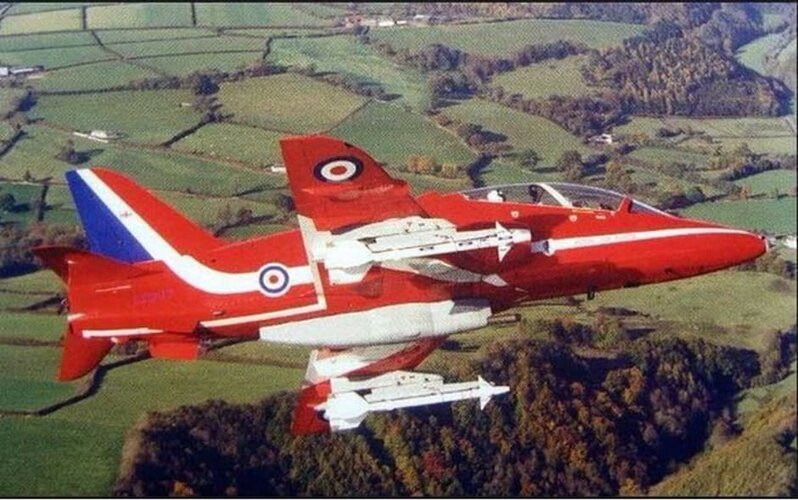- Joined
- 22 April 2012
- Messages
- 2,270
- Reaction score
- 2,045
220 Tornado IDS; replacing 7 Squadrons (6 from 1981) of Vulcan B.2 (56 in total), 5 squadrons of Jaguar and 2 squadrons of RAF Germany Buccaneers: 11 squadrons planned as of 1985 of which 2 were to be recce. there was ultimately a try-national training unit and the TWCU.
165 Tornado ADV; replacing Lightning F.6 in 2 squadrons and Phantoms in 5 squadrons for UK Air Defence: 7 squadrons planned as of 1985, alongside an OCU (229)
60 Harrier GR5 to replace the 3 Harrier GR3 squadrons; a further 36 were ordered later to "maintain the Harrier GR5 force into the 21st Century". Harrier Squadrons varied between 12 (No.1 in the U.K., alongside 233 OCU) an 18 (Nos. 3 & 4 in RAF Germany) aircraft.
42 Buccaneer (60 is a number also used); Upgraded to carry Sea Eagle to serve well into the 90s and almost entirely dedicated to the AShM role - equipped 2 frontline squadrons (Nos. 12 & 208) plus 237 OCU which maintained its shadow squadron SACEUR role.
Worth noting that in the early 1980s there was an expansion of the UK based AD force from 7 squadrons to 9, this would consist of the 7 previously mentioned Tornado ADV squadrons and was facilitated by the retention of Phantoms. There were 72 Sidewinder equipped Hawks (90 had been the original target) though I am unclear as to how many shadow squadrons this equated too.
4 squadrons of Nimrod
The subsequent introduction of the Eurofighter:
250 Eurofighters replacing 75 Jaguar GR1A/T2A in Nos. 6, 54 & 41 squadrons and 237 OCU alongside the Phantoms in Nos. 56, 74 and 228 OCU (No.64 Shadow) squadrons in the UK. In RAF Germany Nos.92 & 19 Phantom squadrons would be replaced. It seems reasonable to assume that two squadrons of RAF Germany Tornado GR.1 squadrons would be redeployed to the UK as replacements for Nos. 12 & 208 Buccaneer anti-ship squadrons as happened in real life, in turn, these would be replaced with Eurofighters. Providing Eurofighters to replace the 4 aircraft in 1435 Flight in the Falklands would also be logical.
That is frontline 9 Squadrons and 1 flight, one also assumes an OCU for each type to be replaced by a single Eurofighter OCU, given that there were still shadow squadrons associated with the legacy OCUs its reasonable to assume there was an ambition to raise two additional frontline squadrons in place of the 2 redundant OCUs which would raise the total to 11. That would leave some airframes to facilitate some consoidation of the Tornado force, perhaps a replacement of 1 each of the fighter and ground attack squadrons.
Thats a potential frontline RAF fighter/attack frontline strength of 32 squadrons (or 33 12 UE squadron equivalents when accounting for Nos. 3 & 4 Harrier squadrons) and 1 flight.
165 Tornado ADV; replacing Lightning F.6 in 2 squadrons and Phantoms in 5 squadrons for UK Air Defence: 7 squadrons planned as of 1985, alongside an OCU (229)
60 Harrier GR5 to replace the 3 Harrier GR3 squadrons; a further 36 were ordered later to "maintain the Harrier GR5 force into the 21st Century". Harrier Squadrons varied between 12 (No.1 in the U.K., alongside 233 OCU) an 18 (Nos. 3 & 4 in RAF Germany) aircraft.
42 Buccaneer (60 is a number also used); Upgraded to carry Sea Eagle to serve well into the 90s and almost entirely dedicated to the AShM role - equipped 2 frontline squadrons (Nos. 12 & 208) plus 237 OCU which maintained its shadow squadron SACEUR role.
Worth noting that in the early 1980s there was an expansion of the UK based AD force from 7 squadrons to 9, this would consist of the 7 previously mentioned Tornado ADV squadrons and was facilitated by the retention of Phantoms. There were 72 Sidewinder equipped Hawks (90 had been the original target) though I am unclear as to how many shadow squadrons this equated too.
4 squadrons of Nimrod
The subsequent introduction of the Eurofighter:
250 Eurofighters replacing 75 Jaguar GR1A/T2A in Nos. 6, 54 & 41 squadrons and 237 OCU alongside the Phantoms in Nos. 56, 74 and 228 OCU (No.64 Shadow) squadrons in the UK. In RAF Germany Nos.92 & 19 Phantom squadrons would be replaced. It seems reasonable to assume that two squadrons of RAF Germany Tornado GR.1 squadrons would be redeployed to the UK as replacements for Nos. 12 & 208 Buccaneer anti-ship squadrons as happened in real life, in turn, these would be replaced with Eurofighters. Providing Eurofighters to replace the 4 aircraft in 1435 Flight in the Falklands would also be logical.
That is frontline 9 Squadrons and 1 flight, one also assumes an OCU for each type to be replaced by a single Eurofighter OCU, given that there were still shadow squadrons associated with the legacy OCUs its reasonable to assume there was an ambition to raise two additional frontline squadrons in place of the 2 redundant OCUs which would raise the total to 11. That would leave some airframes to facilitate some consoidation of the Tornado force, perhaps a replacement of 1 each of the fighter and ground attack squadrons.
Thats a potential frontline RAF fighter/attack frontline strength of 32 squadrons (or 33 12 UE squadron equivalents when accounting for Nos. 3 & 4 Harrier squadrons) and 1 flight.
Last edited:


